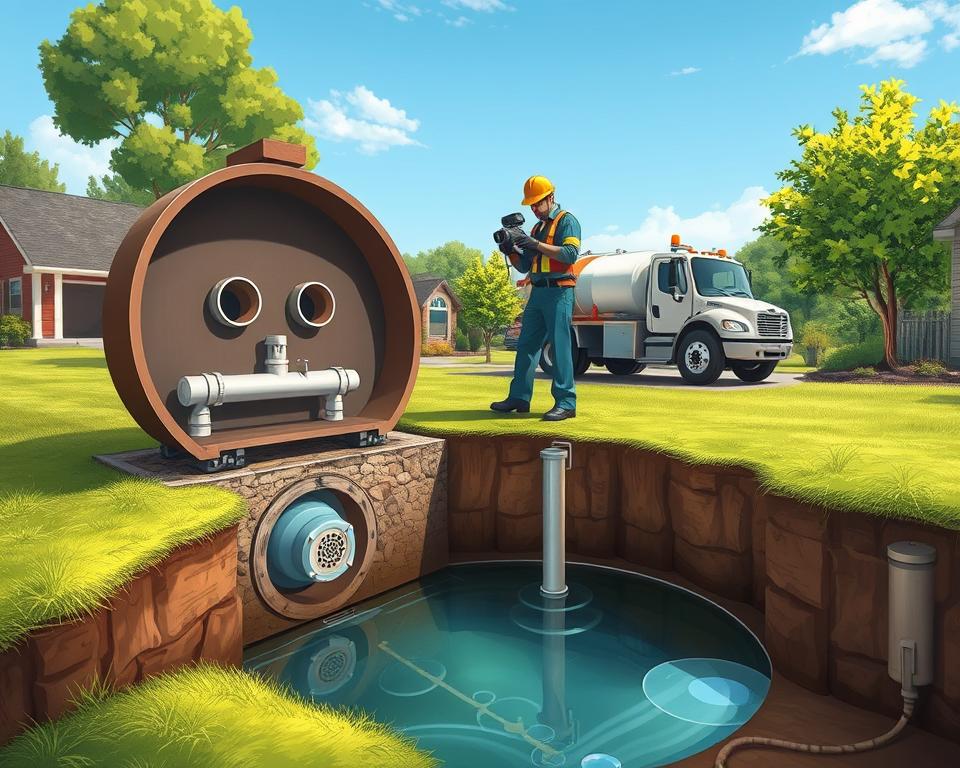Septic Air Pump: Complete Guide for Property Owners
Do you sometimes think about what enhances your aerobic septic system’s effectiveness? The Septic air pump is the often-overlooked key component integral for your system. In this article, you will acquire useful information on the device’s function. It’s necessary for a healthy, well-run Septic tank.
Understanding the significance of a Septic tank air Pump can improve your Septic system’s performance using septic cleaning. It also protects your home equity and surrounding ecosystem. Our handbook will highlight All in Sanitation, a trusted Septic industry leader. They’re ready to serve your Septic aerator Pump needs.
Principal Learnings
- The Septic air Pump is vital for aerated wastewater units.
- Maintaining your Septic system air Pump can optimize overall system function.
- Regular checks increase the service life of your Septic tank air Pump.
- Choosing the correct Septic aerator Pump is key for optimal operation.
- All in Sanitation offers tailored services for Septic air Pump needs.
Exploring Aerobic Septic Systems
Aerobic Septic systems deliver a more effective waste treatment approach by employing oxygen. This technique employs aerobic bacteria living in well-oxygenated environments. These bacteria are more efficient in breaking down organic matter. With the help of Septic aerator Pumps, these systems provide a constant oxygen supply, enhancing the waste decomposition process.
These systems excel in lowering sludge buildup, thanks to the hard work of aerobic bacteria. This decrease in solid waste means reduced upkeep and Pumping is required. Additionally, they reliably process wastewater, leading to barely any odor. This ensures a healthier environment for homeowners and the community overall.
To make sure these systems run properly, it’s necessary to recognize the key Septic system components. These include the Septic tank, treatment chamber, and effluent Pump. Each part has a crucial role, especially the air Pump. It injects oxygen into the tank, central for the aerobic bacteria’s efficiency.
Importance of the Septic Air Pump
The Septic air Pump is pivotal in the performance of aerobic Septic systems. It serves as the system’s “breathing mechanism,” supplying the critical oxygen essential. This oxygen permits aerobic bacteria to flourish and digest waste properly. If the Pump fails, the system’s effectiveness drops, leading to sludge collection and possible odors.
Such issues can interfere with Septic system operations and pose environmental hazards. By recognizing how vital the Septic air Pump is, homeowners can respond ahead of time. They can keep its top function through scheduled service. This stops failures, prevents costly repairs, and protects the aerobic system’s integrity.
Major Benefits of Using a Septic Air Pump
Employing a Septic air Pump markedly increases the performance of Septic systems. Septic air Pumps are crucial as they speed up the digestion of waste. This is achieved by oxygenating the treatment process, promoting aerobic bacteria growth. These bacteria are essential for efficient waste treatment.
They’re also instrumental in cutting foul smells. With more active aerobic processes, waste breaks down faster, thus lessening odors. This creates a nicer atmosphere for homeowners.
Another significant benefit is the cut in sludge buildup. Consequently, tanks require less frequent Pumping, conserving both money and time. Enhanced processing not only cuts expenses but also lengthens the lifespan of the drain field.
Looking after these Pumps well means less frequent repair costs and satisfying regulatory standards. Thus, the advantages of Septic air Pumps are not only for homeowners. They also benefit environmental health by raising waste management practices.
| Benefit | Description |
|---|---|
| Fast Waste Breakdown | Greater aerobic activity hastens the decomposition process. |
| Minimized Odor Emissions | Superior treatment efficacy produces fewer odors. |
| Reduced Sludge Buildup | Less frequent Pumping and maintenance are needed. |
| Extended Drain Field Life | Better treatment equals a healthier drain field. |
| Cost Savings | Lower risk of repairs and regulatory compliance cost. |

Selecting the Best Septic Air Pump
Picking the proper Septic air Pump is essential for an optimized aerobic system. Homeowners ought to review various factors for the ideal match. The dimensions of the tank and the airflow requirements play a crucial role the Pump’s efficiency.
To decide wisely, it’s important to recognize the air Pumps available. There are mainly two types: diaphragm Pumps and rotary vane Pumps. Each comes with particular pluses, which should be paired with your home’s individual circumstances and operational profile.
Energy use also deserves attention. Selecting a Pump that minimizes energy use while supplying the needed airflow can result in noticeable cost cuts. Guidance from All in Sanitation consultants can be extremely useful. They help ensure the Pump you choose suits your system’s requirements seamlessly.
Common Types of Septic Air Pumps
Homeowners can select wisely by knowing the multiple Septic air Pumps available. There are mainly two types: diaphragm Pumps and rotary vane Pumps. Each has its individual functions and benefits.
Diaphragm Pumps, valued for their quiet operation, are commonly used for residential Septic systems. They maintain energy efficiency while delivering reliable air delivery. Their constant performance matches smaller systems, meeting the needs of many homeowners.
Rotary vane Pumps, however, are better suited for higher-capacity or commercial systems. These Pumps provide more power, essential in handling bigger loads. Their solid build allows efficient operation in heavy-duty Septic systems.
| Type of Pump | Best Use | Advantages |
|---|---|---|
| Diaphragm Pumps | Residential Systems | Quiet operation, energy-efficient, reliable air flow |
| Rotary Vane Pumps | Larger or Commercial Systems | Powerful performance, high capacity, durable construction |
Appreciating the distinctions in Septic air Pumps is essential for upgrades or replacements. Each Pump type delivers specific features to satisfy various needs. This ensures peak performance for any system.
How to Tell You Need a Septic Air Pump Replacement
Homeowners must look out for Pump failure signs in their Septic systems. Some indicators indicate the need for a Septic air Pump replacement. These ensure continued performance. Noticing these early sidesteps larger issues.
Signs of potential problems include:
- Unusual noises from the Pump, like clanking or buzzing, might mean internal damage.
- A clear lack of air output suggests the Pump isn’t working well, reducing efficiency.
- Frequent electrical problems, such as tripped breakers or flickering lights, could point to overloading.
- Visible damage on the Pump unit, with breaks or leaks, demands quick action.
- Bad smells in the yard often reveal a compromised Pump, highlighting ineffective effluent aeration.
Detecting these signs early stops costly fixes or total system failure. Conducting consistent assessments helps identify these issues. It also shows if you need a new Septic air Pump.
Service Tips for Your Septic Air Pump
For an efficient Septic air Pump, routine upkeep is necessary. This guarantees that your system functions properly. Homeowners can apply several practical care strategies for peak results.
Bi-annually, carry out a careful inspection for wear or damage. It is also necessary to swap out the filters as recommended. This reduces clogs that could hurt efficiency.
The Pump should be placed on a firm base to lessen vibrations, which could damage it over time. A protective cover is critical too. It defends against debris and water, maintaining the Pump’s functionality.
Regular servicing can significantly prolong the life of your Pump. In turn, this benefits the Septic system’s performance collectively.
| Maintenance Task | Frequency | Benefits |
|---|---|---|
| Inspect Pump for damage | Every 6 months | Identifies issues early |
| Replace filters | As needed | Improves efficiency |
| Check surface stability | Annually | Reduces vibrations |
| Clear debris around Pump | Monthly | Avoids obstruction |
Placing Your Septic Air Pump
Proper installation of your Septic air Pump is key for its optimal operation. First, pick a stable, moisture-free area for placement. The chosen spot should safely support the Pump’s weight without issue.
To successfully install your Pump on your own, heed the following guidelines:
- Prepare all necessary items, including the Pump, a power source, and hose fittings.
- Carefully read the manufacturer’s guidelines before starting your installation.
- Confirm every connection is tight to stop air leaks that reduce performance.
- After assembly, conduct a test to verify the system works as intended.
If the installation process seems daunting, reach out to All in Sanitation. Their professionals can sidestep common errors, guaranteeing your setup complies with relevant safety requirements.
Advantages of Using All in Sanitation for Your Septic Air Pump Needs
When choosing a Septic service provider, the choice is important. All in Sanitation distinguishes itself by delivering dependable Septic air Pumps. They satisfy diverse homeowner requirements with a wide selection of premium products. This ensures customers get an appropriate match for their Septic systems.
What further defines All in Sanitation is beyond their broad product lineup. Their focus to exceptional customer service is also critical. Homeowners enjoy professional guidance, leading them to trusted Septic solutions. This partnership is essential to tailor each solution to meet specific needs.
All in Sanitation also puts first aftercare to secure lasting satisfaction. Their devotion extends beyond the initial sale. They provide ongoing support to preserve Septic systems working well for the long haul.
Expense Overview for Septic Air Pumps
Grasping the costs linked to Septic air Pumps is vital for homeowners operating aerobic Septic systems. At first, one faces the purchase price, which includes the Pump and associated accessories. Installation expenses vary, according to the system’s complexity and any adjustments required.
Ongoing upkeep forms an additional cost layer. Regular inspections can head off bigger issues, which can mean savings. Homeowners should plan for Septic maintenance to maintain the Pump’s effectiveness and longevity. Such planning sidesteps expensive repairs later on, showing the benefit of proactive maintenance.
| Cost Component | Average Cost Range |
|---|---|
| Septic Air Pump | $500 – $1,200 |
| Installation | $300 – $800 |
| Annual Maintenance | $150 – $400 |
| Potential Repair Costs | $1,000 – $5,000 |
Breaking down Septic air Pump expenses into distinct parts helps homeowners in cost forecasting. This thorough approach ensures the system’s steady performance and their confidence.
In Summary
For homeowners with aerobic Septic systems, looking after Septic setups is key. The right Septic air Pump improves waste processing and lengthens your system’s life. Practising routine maintenance and promptly addressing issues stops large repair bills and disruptions.
Selecting a Septic air Pump demands careful thought. This guide highlighted how to choose wisely about installation and replacement. With All in Sanitation’s guidance, you can navigate your Septic systems’ complexities confidently.
Maintaining your Septic air Pump enhances your system’s operation and life span. It guarantees a reliable and proper operation over time. Bear in mind, your home’s wastewater management is greatly improved by proper care.


